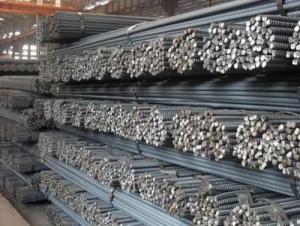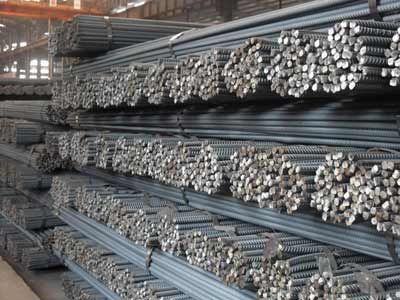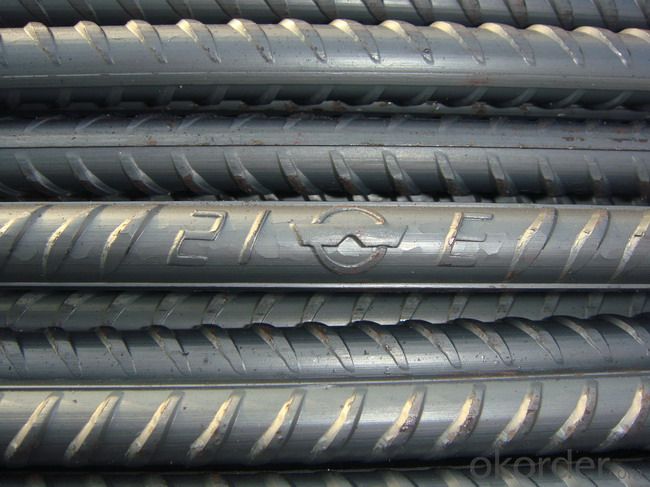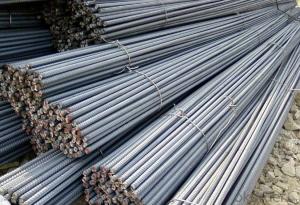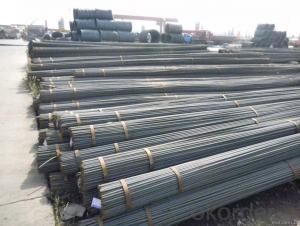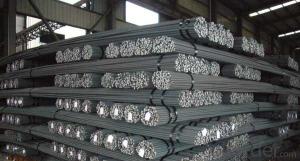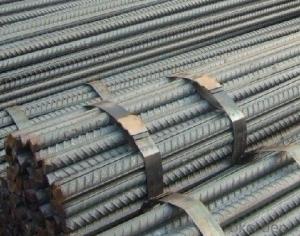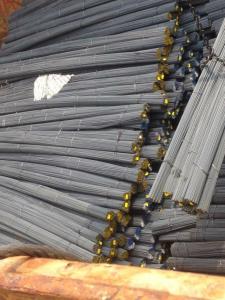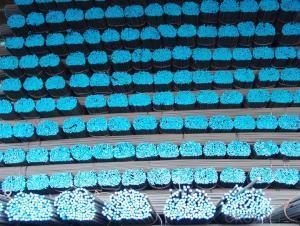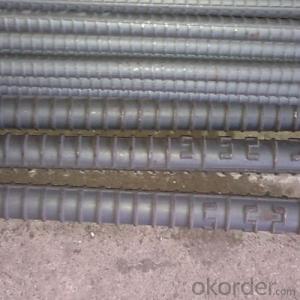8mm*50.27mm deformed steel bar deformed steel bar
- Loading Port:
- Tianjin
- Payment Terms:
- TT or LC
- Min Order Qty:
- 25 m.t.
- Supply Capability:
- 100000 m.t./month
OKorder Service Pledge
OKorder Financial Service
You Might Also Like
Product Description:
OKorder is offering 8mm*50.27mm deformed steel bar deformed steel bar at great prices with worldwide shipping. Our supplier is a world-class manufacturer of steel, with our products utilized the world over. OKorder annually supplies products to European, North American and Asian markets. We provide quotations within 24 hours of receiving an inquiry and guarantee competitive prices.
Product Applications:
8mm*50.27mm deformed steel bar are ideal for structural applications and are widely used in the construction of buildings and bridges, and the manufacturing, petrochemical, and transportation industries.
Product Advantages:
OKorder's deformed steel bar are durable, strong, and resist corrosion.
Main Product Features:
· Premium quality
· Prompt delivery & seaworthy packing (30 days after receiving deposit)
· Corrosion resistance
· Can be recycled and reused
· Mill test certification
· Professional Service
· Competitive pricing
Product Specifications:
| Minimum Order Quantity: | 25MT | Unit: | m.t. | Loading Port: | China Main Port |
| Supply Ability: | 800000 MT/YEAR | Payment Terms: | TT or LC |
Product Description:
Specifications of Deformed Steel Bar:
Standard | GB | HRB335, HRB400, HRB500 | |
UK | G460B, B500A, B500B,B500C | ||
USA | GR40, GR60 | ||
Diameter | 6mm,8mm,10mm,12mm,14mm,16mm,18mm,20mm, 22mm,25mm,28mm,32mm,36mm,40mm,50mm | ||
Length | 6M, 9M,12M or as required | ||
Place of origin | Hebei, China mainland | ||
Application | building,construction,road,bridge etc | ||
Brand name | DRAGON | ||
Theoretical weight and section area of each diameter as below for your information:
Diameter(mm) | Section area (mm²) | Mass(kg/m) |
6 | 28.27 | 0.222 |
8 | 50.27 | 0.395 |
10 | 78.54 | 0.617 |
12 | 113.1 | 0.888 |
14 | 153.9 | 1.21 |
16 | 201.1 | 1.58 |
18 | 254.5 | 2.00 |
20 | 314.2 | 2.47 |
22 | 380.1 | 2.98 |
25 | 490.9 | 3.85 |
28 | 615.8 | 4.83 |
32 | 804.2 | 6.31 |
36 | 1018 | 7.99 |
40 | 1257 | 9.87 |
50 | 1964 | 15.42 |
Usage and Applications of Deformed Steel Bar:
Deformed bar is widely used in buildings, bridges, roads and other engineering construction. Big to highways, railways, bridges, culverts, tunnels, public facilities such as flood control, dam, small to housing construction, beam, column, wall and the foundation of the plate, deformed bar is an integral structure material. With the development of world economy and the vigorous development of infrastructure construction, real estate, the demand for deformed bar will be larger and larger..
Packaging & Delivery of Deformed Steel Bar:
Packaging Detail: products are packed in bundle and then shipped by container or bulk vessel, deformed bar is usually naked strapping delivery, when storing, please pay attention to moisture proof. The performance of rust will produce adverse effect.
Each bundle weight: 2-3MT, or as required
Payment term: TT or L/C
Delivery Detail: within 45 days after received advanced payment or LC.
Label: to be specified by customer, generally, each bundle has 1-2 labels
Trade terms: FOB, CFR,
Note:
1. Our products are produced according to national standard (GB), if not, supply according to national standards (GB) or agreement as customer required.
2. Other Grade and Standard Deformed Steel Bar we can supply:
Grade: GR40/GR60, G460B/B500A/B500B/B500C,BST500S
Standard: ASTM, BS, DIN
The Minimum Order Quantity of these products is high, and need to be confirmed.
3. We can not only supply Deformed Steel Bar; if you need anything about building materials, please contact us for further information.
4. Please send us your detail specifications when inquire. We will reply to you as soon as possible. We sincerely hope we can establish a long stable business relationship.
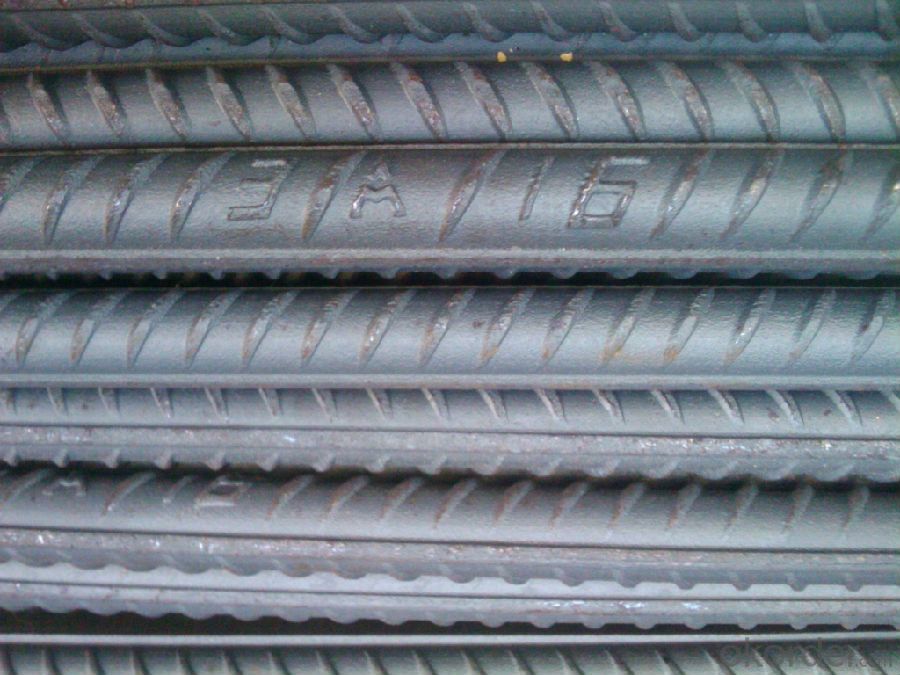
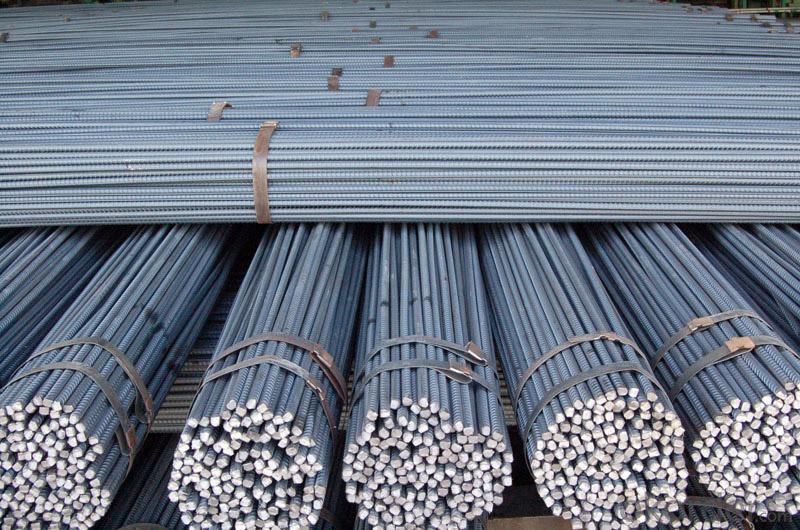
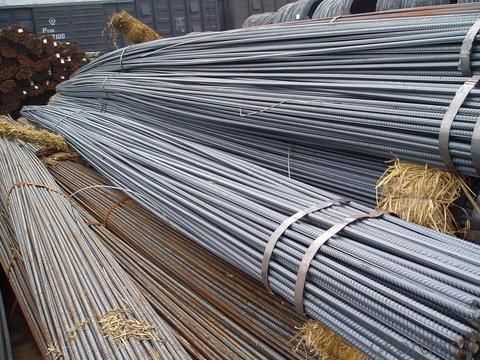
FAQ:
Q1: Why buy Materials & Equipment from OKorder.com?
A1: All products offered byOKorder.com are carefully selected from China's most reliable manufacturing enterprises. Through its ISO certifications, OKorder.com adheres to the highest standards and a commitment to supply chain safety and customer satisfaction.
Q2: Can stainless steel rust?
A2: Stainless does not "rust" as you think of regular steel rusting with a red oxide on the surface that flakes off. If you see red rust it is probably due to some iron particles that have contaminated the surface of the stainless steel and it is these iron particles that are rusting. Look at the source of the rusting and see if you can remove it from the surface.
- Q: Cold drawn steel wire is a round bar or thread steel in Construction Engineering
- Cold drawn steel wire belongs to round bar in building engineering, and it is thread steel after coining. But the material of steel is not good. Who knows what material he made?.
- Q: What are the advantages of using fiber-reinforced polymer (FRP) rebars over steel rebars?
- There are several advantages of using fiber-reinforced polymer (FRP) rebars over steel rebars. Firstly, FRP rebars are significantly lighter than steel rebars, making them easier to handle and transport. Additionally, FRP rebars have a higher tensile strength than steel rebars, allowing for greater flexibility in design and reducing the need for additional reinforcement. FRP rebars are also non-corrosive, unlike steel rebars which can rust over time, making them more durable and longer-lasting. Lastly, FRP rebars are non-conductive, making them suitable for use in areas with electrical or magnetic fields. Overall, the use of FRP rebars offers numerous advantages in terms of weight, strength, durability, and versatility.
- Q: How do steel rebars affect the fire resistance of concrete structures?
- Concrete structures can greatly increase their ability to withstand fire by incorporating steel rebars. These rebars serve as reinforcement, providing extra strength and stability to the structure and enabling the concrete to endure the intense heat of a fire. The fire resistance of concrete structures primarily relies on the fact that concrete has low thermal conductivity. When exposed to high temperatures, concrete undergoes spalling, where the outer layer breaks off due to the rapid expansion of trapped water. However, the presence of steel rebars helps prevent spalling by holding the concrete together and preventing it from disintegrating. Moreover, steel rebars have a higher melting point than concrete. This means that even when exposed to extreme heat, the rebars maintain their strength and integrity. Consequently, the overall structural stability of the concrete structure remains intact, even in the presence of fire. Steel rebars also act as a heat sink, absorbing and dissipating heat away from the surrounding concrete. This dissipation of heat prevents the formation and spread of localized hotspots throughout the structure, thereby reducing the risk of structural failure. To further enhance the fire resistance of concrete structures, specialized types of steel rebars, known as fire-resistant or fire-rated rebars, can be utilized. These rebars are specifically designed to withstand high temperatures for extended periods without losing their strength. They are often coated with materials such as epoxy or intumescent coatings, which offer additional protection against fire. In conclusion, steel rebars play a vital role in improving the fire resistance of concrete structures. Their presence enhances the overall structural stability, minimizes spalling, dissipates heat, and provides additional strength to withstand the intense heat generated during a fire.
- Q: Are there any limitations on using steel rebars in cold climates?
- Yes, there are limitations on using steel rebars in cold climates. The main limitation is the potential for the steel to become brittle and lose its strength in extremely cold temperatures. This can result in reduced durability and structural integrity of the reinforced concrete. To overcome this limitation, additional measures such as using low-temperature resistant steel or providing proper insulation and heating during construction may be necessary.
- Q: How are steel rebars stored and transported?
- Steel rebars are typically stored and transported in bundles or coils. They are commonly stored in open yards or warehouses, with proper stacking and support to prevent damage or deformation. During transportation, rebars are loaded onto trucks or flatbed trailers, secured with straps or chains to ensure stability, and transported to construction sites or steel fabrication facilities.
- Q: What is the process of reinforcing existing concrete structures with steel rebars?
- Enhancing the strength and durability of existing concrete structures with steel rebars involves a series of steps. To begin, a thorough assessment of the concrete structure is conducted to determine its condition and identify areas in need of reinforcement. This involves inspecting the concrete for cracks, signs of degradation, or any other structural issues. Once the areas requiring reinforcement are identified, the next step is surface preparation. This involves cleaning the concrete surface to remove any loose debris, dirt, or contaminants that could hinder the bonding of the rebars with the concrete. Various methods, such as pressure washing or sandblasting, can be used for this purpose. Following surface preparation, the rebars are strategically placed within the concrete structure. The positioning and spacing of the rebars are crucial to ensure optimal reinforcement and structural integrity. This is typically accomplished by drilling holes or creating channels in the concrete where the rebars will be placed. Afterward, the rebars are inserted into the holes or channels, ensuring proper alignment and securing. The rebars are typically cut to the required length and bent into the desired shape to meet the specific reinforcement needs of the structure. Once the rebars are in place, they are anchored or secured to the existing concrete by various means. This can be achieved through the use of epoxy adhesive, mechanical anchors, or embedding the rebars into fresh concrete poured around them. Finally, the concrete is restored to its original condition, covering the rebars and creating a smooth and even surface. This may involve patching up any holes or channels created during the reinforcement process and finishing the surface to match the surrounding concrete. In conclusion, the process of reinforcing existing concrete structures with steel rebars necessitates careful planning, proper surface preparation, precise placement of rebars, secure anchoring, and appropriate finishing to achieve a strengthened and long-lasting structure.
- Q: What is the role of steel rebars in minimizing creep deformation in concrete?
- Steel rebars play a crucial role in minimizing creep deformation in concrete structures. Creep deformation refers to the gradual and permanent deformation that occurs in concrete over time under sustained loads. This phenomenon can lead to structural instability and compromise the overall integrity of the concrete. Steel rebars, also known as reinforcement bars, are embedded within the concrete matrix to provide additional strength and stiffness. These rebars help counteract the tensile forces exerted on the concrete, as concrete is weak in tension but strong in compression. By resisting the tensile stresses, the rebars prevent the concrete from cracking and experiencing excessive creep deformation. The presence of steel rebars in concrete also improves the load-carrying capacity of the structure, allowing it to bear heavier loads without excessive deformation. This is achieved by distributing the applied load more evenly throughout the concrete, reducing localized stress concentrations and minimizing the potential for creep deformation. Furthermore, steel rebars act as a restraining element, limiting the movement of the concrete and reducing the potential for creep. The high modulus of elasticity and low thermal expansion coefficient of steel make it an ideal material for reinforcing concrete and restraining its creep behavior. In summary, the role of steel rebars in minimizing creep deformation in concrete is multi-fold. They provide additional strength and stiffness to counteract tensile forces, improve load-carrying capacity, and act as a restraining element, all of which contribute to maintaining the structural integrity of the concrete over time.
- Q: Can steel rebars be used in the construction of data centers and IT facilities?
- Yes, steel rebars can be used in the construction of data centers and IT facilities. Steel rebars provide structural reinforcement and enhance the strength and durability of the building, making them suitable for supporting heavy equipment, racks, and servers. Additionally, steel rebars offer excellent fire resistance and can help ensure the safety and security of the data center or IT facility.
- Q: How do steel rebars contribute to the overall stiffness of a structure?
- Steel rebars contribute to the overall stiffness of a structure by providing reinforcement and enhancing its load-bearing capacity. When embedded within concrete, steel rebars form a composite material known as reinforced concrete, which combines the compressive strength of concrete with the tensile strength of steel. The primary function of steel rebars is to resist tensile forces that can cause concrete to crack or fail. Concrete has excellent compressive strength but is weak in tension. By adding steel rebars, the overall stiffness of the structure is increased, as the rebars take up the tensile stresses and prevent the concrete from failing under tension. The rebars are strategically placed within the concrete to resist anticipated forces and distribute them evenly across the structure. As external loads are applied to the structure, such as the weight of the building or environmental forces like wind or earthquakes, the rebars counteract the tension caused by these loads. This reinforcement ensures that the structure remains intact and stable, preventing any major deformations or collapse. Moreover, steel rebars also contribute to the ductility of the structure. Ductility refers to the ability of a material to undergo deformation without fracturing. Steel has high ductility, and when incorporated into reinforced concrete, it allows the structure to withstand some level of flexure and movement without compromising its overall strength and stability. This improved ductility enhances the structural resilience, making the building more resistant to extreme external forces. In summary, steel rebars play a crucial role in contributing to the overall stiffness of a structure by reinforcing the concrete and providing tensile strength. They prevent cracking and failure under tension, distribute forces evenly, and increase the structural resilience and ductility. By combining the compressive strength of concrete with the tensile strength of steel, steel rebars ensure that the structure can withstand various loads and maintain its stability and integrity over time.
- Q: How do steel rebars affect the cost of a construction project?
- Steel rebars can significantly affect the cost of a construction project because they are a crucial component in reinforced concrete structures. The cost of steel rebars depends on their quantity, grade, and size, and it can greatly impact the overall project budget. Additionally, the transportation and installation costs associated with steel rebars should also be taken into account. Therefore, careful planning and consideration of the type and amount of steel rebars required are essential to manage and optimize the project's cost.
Send your message to us
8mm*50.27mm deformed steel bar deformed steel bar
- Loading Port:
- Tianjin
- Payment Terms:
- TT or LC
- Min Order Qty:
- 25 m.t.
- Supply Capability:
- 100000 m.t./month
OKorder Service Pledge
OKorder Financial Service
Similar products
Hot products
Hot Searches
Related keywords
